44 Types of Hibiscus That Will Add Colorful Blooms to Your Garden
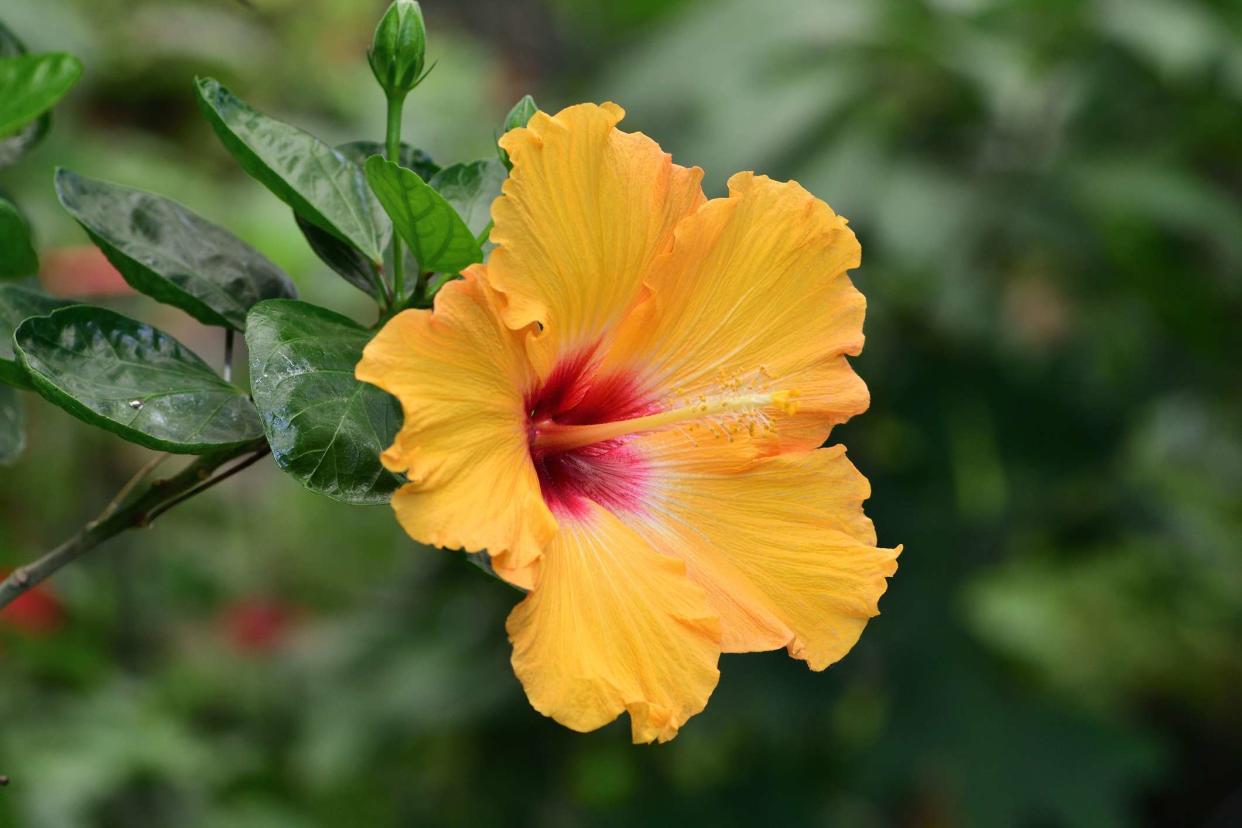
Tom Meaker / EyeEm / Getty Images
Orange tropical hibiscus flower (hibiscus rosa-sinensis)Hibiscus is a genus of flowering plants that includes hundreds of species and even more man-made hybrids and cultivars. Part of the mallow family, hibiscus plants are known for their upright growth habit and colorful, cup-shaped flowers, which often have dark-colored centers and prominent stamens. Plants in this genus include annuals, perennials, shrubs, and even trees.
Many hibiscus plants can grow well in containers or other compact spaces, though others are more suitable as tall hedge or border plants.
Here are 44 types of hibiscus plants to consider for your garden, porch, or patio.
Swamp Hibiscus
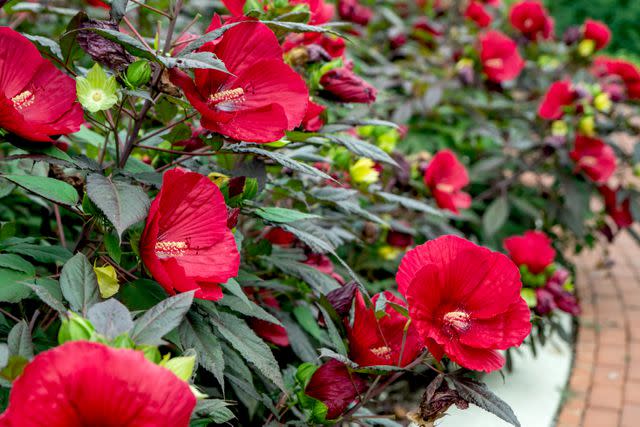
The Spruce / Adrienne Legault
A large, vigorous shrub, swamp hibiscus is known for its vivid red flowers. It grows well in sunny, humid conditions, and true to its name, it can thrive in wet soils along ponds and creeks that other plants can't tolerate. In cold regions, apply a layer of mulch in late fall to protect the plant during winter.
Name: Swamp hibiscus (Hibiscus coccineus)
USDA Hardiness Zone: 6-9
Mature Height: Over 6 ft.
Sun Exposure: Full, partial
Soil Needs: Sand, clay, loam
Flower Color: Red
Water: Keep soil evenly moist
Cotton Rose
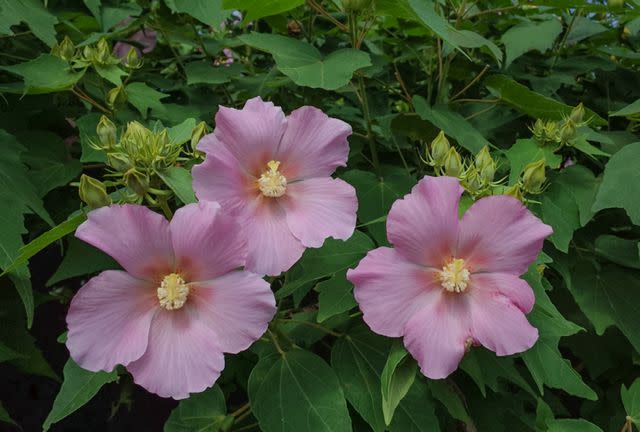
The Spruce / K. Dave
Fast-growing cotton rose can grow so large that it resembles a tree more than a shrub. This low-maintenance, deer-resistant hibiscus species is known for its large, long-blooming flowers in shades of white, pink, and red, which are followed by fuzzy seed pods that give the plant its common name. Prune away dead growth from the previous season in late winter or early spring.
Name: Cotton rose (Hibiscus mutabilis)
USDA Hardiness Zone: 7–11
Mature Height: 6–15 ft.
Sun Exposure: Full, partial
Soil Needs: Loamy, well-drained
Flower Color: White, pink, red
Water: Keep soil moist
Rose of Sharon
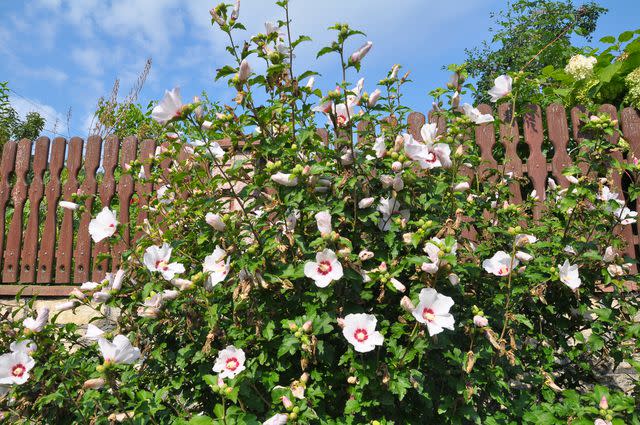
Orest Lyzhechka / Getty Images
Rose of Sharon is a garden favorite for its colorful, showy blossoms with dark-colored centers. This easy-growing flowering shrub grows into an upright vase shape that can also be pruned into a treelike shape with a central stalk. Note that rose of sharon will self-seed, so be ready to remove "volunteers" if you'd like to keep it contained.
Name: Rose of Sharon (Hibiscus syriacus)
USDA Hardiness Zone: 5–8, USDA
Mature Height: 8–12 ft.
Sun Exposure: Full, partial
Soil Needs: Moist, well-drained
Flower Color: Pink, purple, lavender, red, blue, white
Water: Keep soil moist, but mature shrubs can tolerate some drought
Rose of Sharon 'Blue Chiffon'

The Spruce / David Beaulieu
Rose of sharon comes in many unique cultivars, including 'Blue Chiffon', a specimen with uncommon blue-tinged flowers and a lacy ruffle of inner petals. This tall shrub offers a rounded growth habit and thrives in a variety of well-drained soils. Look for blooming to begin in high summer and go through fall.
Name: Rose of Sharon 'Blue Chiffon' (Hibiscus syriacus 'Blue Chiffon')
USDA Hardiness Zone: 5–9
Mature Height: 8–12 feet tall
Sun Exposure: Full, partial
Soil Needs: Moist, well-drained
Flower Color: Pale blue
Water: Keep soil moist
Rose of Sharon 'Sugar Tip'
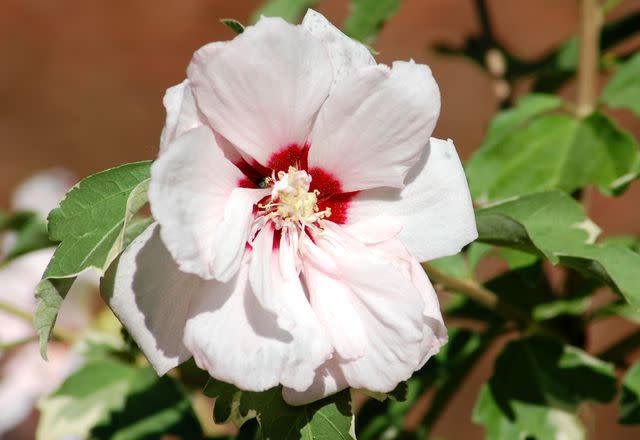
The Spruce / David Beaulieu
This double-petaled rose of sharon cultivar produces cotton candy-colored blooms with deep red centers. Topping out around six feet tall, it's more compact than other varieties and offers attractive green and white variegated leaves. 'Sugar Tip' doesn't produce seeds that will spread new plants, making it a lower-maintenance option.
Name: Rose of Sharon 'Sugar Tip' (Hibiscus syriacus 'Sugar Tip' )
USDA Hardiness Zone: 5–8
Mature Height: 5-6 ft.
Sun Exposure: Full sun
Soil Needs: Moist, well-drained soil
Flower Color: Pale pink
Water: Keep soil moist
Rose of Sharon 'Red Heart'
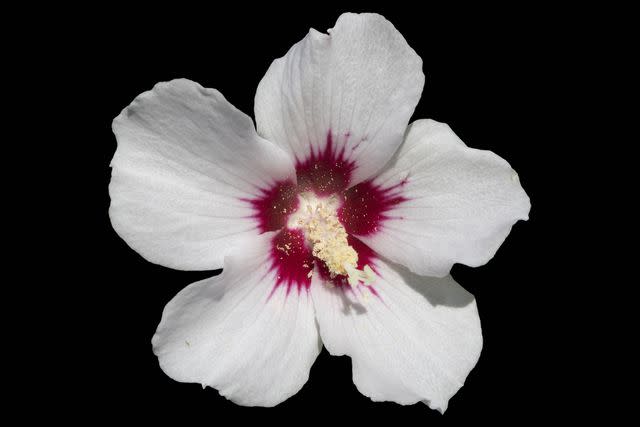
matricul/Getty Images
"Red Heart" is so named for the color of its center.Bicolor rose of Sharon cultivar 'Red Heart' blooms with striking, pure white flowers with deep red throats that highlight pale yellow stamens. Each flower lasts for one day, with blooms appearing in midsummer and continuing through fall. Thanks to its strong stems, 'Red Heart' works well as a hedge plant.
Name: Rose of Sharon 'Red Heart '(Hibiscus syriacus 'Red Heart')
USDA Hardiness Zone: 5–9
Mature Height: 8–10 ft.
Sun Exposure: Full, partial
Soil Needs: Rich, well-drained
Flower Color: White, red
Water: Water often and deeply to keep soil moist
Rose of Sharon 'White Chiffon'
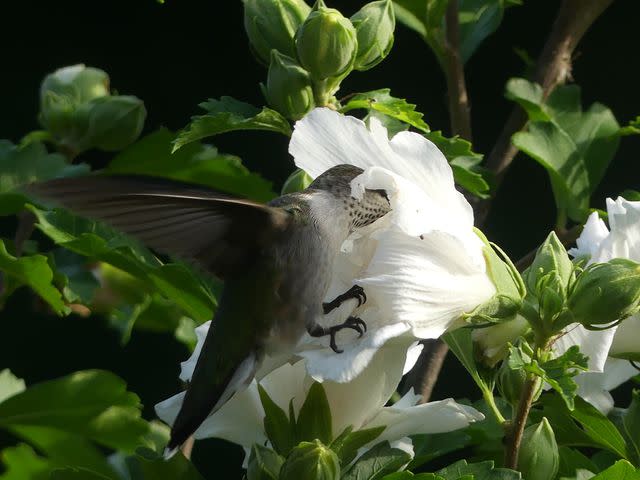
Donna Braswell / Getty Images
Many rose of Sharon varieties with white flowers have dark-colored centers, but the blooms on 'White Chiffon' are a pure, snowy white throughout. A ruffle of petals around the stamen adds visual interest and a delicate look. This versatile cultivar is heat, salt, and drought tolerant and blooms throughout the summer.
Name: Rose of Sharon 'White Chiffon' (Hibiscus syriacus 'White Chiffon')
USDA Hardiness Zone: 5-9
Mature Height: 8–12 ft.
Sun Exposure: Full, partial
Soil Needs: Well-drained soil
Flower Color: White
Water: Keep soil moist
Rose of Sharon 'Aphrodite'
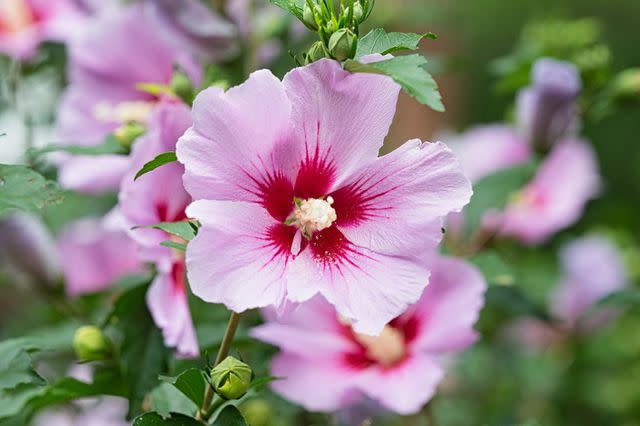
july7th / Getty Images
If you're looking for a type of hibiscus shrub with a bushy, full growth habit, consider rose of Sharon 'Aphrodite', which grows almost as wide as it does tall. Its attractive flowers are large and bright pink with deep red throats, and it won't self-seed—a bonus in some regions where rose of Sharon can become invasive. Note that 'Aphrodite' needs more sun than some other hibiscus types.
Name: Rose of Sharon 'Aphrodite' (Hibiscus syriacus 'Aphrodite')
USDA Hardiness Zone: 5-8
Mature Height: 6–10 ft.
Sun Exposure: Full
Soil Needs: Well-drained
Flower Color: Pink
Water: Keep soil moist
Rose of Sharon 'Blue Satin'
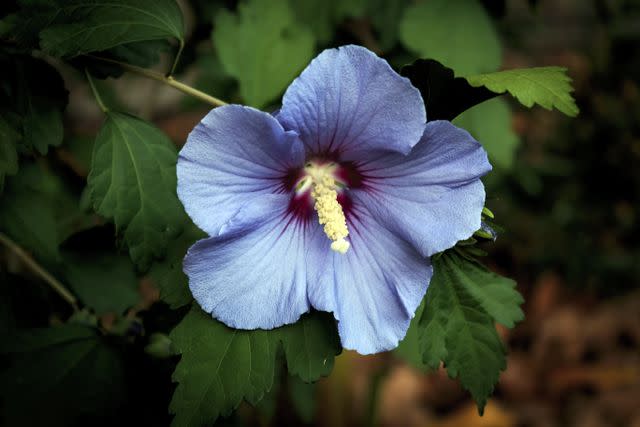
One of the most stunning types of hibiscus out there, rose of Sharon 'Blue Satin' has showy, blue-violet flowers with deep red throats that show off prominent yellow stamens. This tall shrub also offers versatility, including drought tolerance and salt tolerance. It's also easy-growing once established and won't self-seed.
Name: Rose of Sharon 'Blue Satin' (Hibiscus syriacus 'Blue Satin')
USDA Hardiness Zone: 5-9
Mature Height: 8-12 ft.
Sun Exposure: Full, partial
Soil Needs: Well-drained
Flower Color: Blue
Water: Keep soil evenly moist
Rose of Sharon 'Blueberry Smoothie'
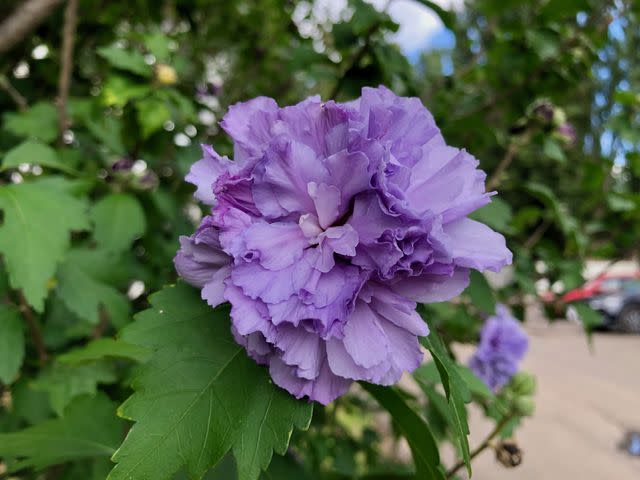
k5k / Getty Images
The showy double blooms of rose of Sharon 'Blueberry Smoothie' are shades of violet that can appear genuinely blue. You can allow this spectacular shrub to grow tall and full or prune it into a centralized, treelike shape. Plant this seedless cultivar in a spot with lots of sun where its abundant summer blooms can be appreciated.
Name: Rose of Sharon 'Blueberry Smoothie' (Hibiscus syriacus 'Blueberry Smoothie')
USDA Hardiness Zone: 5-8
Mature Height: 8 ft.
Sun Exposure: Full, partial
Soil Needs: Moist, well-drained
Flower Color: Blue
Water: Water deeply to keep soil moist
Rose of Sharon 'Lavender Chiffon'
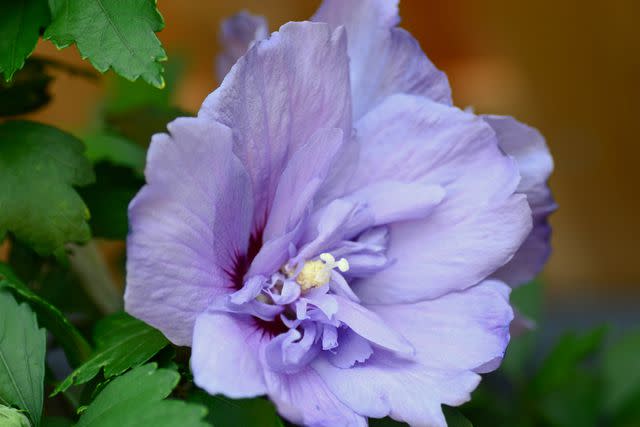
49pauly / Getty Images
Rose of Sharon 'Lavender Chiffon' produces light purple, semi-double flowers with subtle red veins. This long-blooming, seed-free variety will grow quite full and bushy if left unpruned, making it an excellent hedge or privacy screen when planted en masse. You can also prune the plant in early spring to shape its growth or plant it in a large pot with other species to keep it contained.
Name: Rose of Sharon 'Lavender Chiffon' (Hibiscus syriacus 'Lavender Chiffon')
USDA Hardiness Zone: 5-9
Mature Height: 8-12 ft.
Sun Exposure: Full, partial
Soil Needs: Moist, rich, well-drained
Flower Color: Purple
Water: Keep soil evenly moist
Rose of Sharon 'Lil Kim'
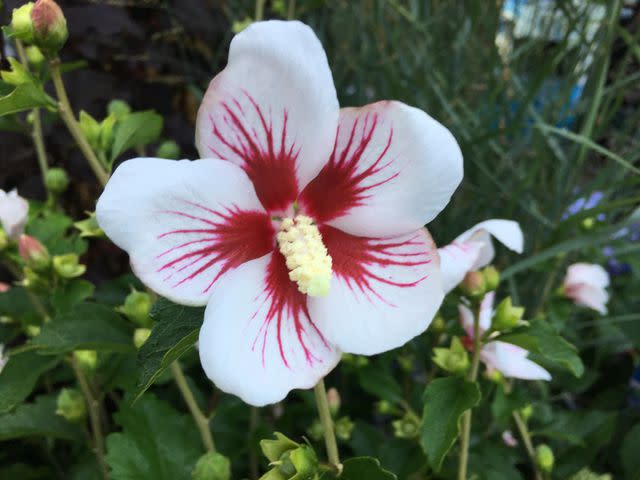
Flickr / Estabrooks
If you love the look of this hibiscus species but don't have lots of space for tall, bushy plantings, consider 'Lil Kim', a rose of Sharon cultivar that tops out around four feet in height. This dwarf shrub offers abundant white blooms with vivid red centers and prominent veining. Plant it in a container or along a border to enjoy blooms all summer long.
Name: Rose of Sharon 'Lil Kim' (Hibiscus syriacus 'Lil Kim')
USDA Hardiness Zone: 5-9
Mature Height: 3-4 ft.
Sun Exposure: Full, partial
Soil Needs: Moist, well-drained
Flower Color: White, magenta
Water: Keep soil evenly moist
Rose of Sharon 'Lucy'

Rose of Sharon 'Lucy' blooms with showy, full, double-petaled flowers in a rich magenta color. With its full, bushy growth habit, this seedless cultivar makes an excellent hedge plant or privacy screen, or you can prune away lower limbs in spring to create a treelike shape. Plant in full sun to enjoy the most abundant blooms.
Name: Rose of Sharon 'Lucy' (Hibiscus syriacus 'Lucy')
USDA Hardiness Zone: 5-8
Mature Height: 6-8 ft.
Sun Exposure: Full, partial
Soil Needs: Moist, well-drained
Flower Color: Reddish-fuchsia
Water: Water deeply each week to keep soil moist
Rose of Sharon 'Minerva'
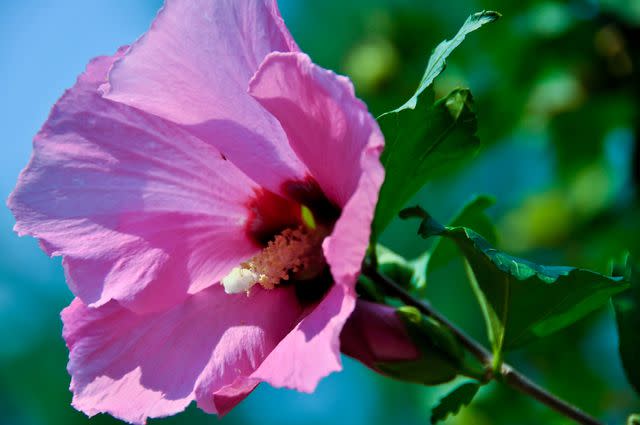
likeaduck / flickr / CC BY 2.0 DEED
'Minerva' makes a colorful statement with large, pinkish-purple petals, a deep red throat, and contrasting ivory stamen. This drought-tolerant hibiscus type enjoys moist soil but can tolerate drier conditions than some rose of Sharon cultivars. Prune back a few buds in late winter or early spring to encourage a fuller, bushier growth habit and larger blooms later in the season.
Name: Rose of Sharon 'Minerva' (Hibiscus syriacus 'Minerva')
USDA Hardiness Zone: 5-8
Mature Height: 10 ft.
Sun Exposure: Full, partial
Soil Needs: Loamy, well-drained
Flower Color: Pinkish-purple
Water: Keep soil evenly moist
Rose of Sharon 'Purple Pillar'
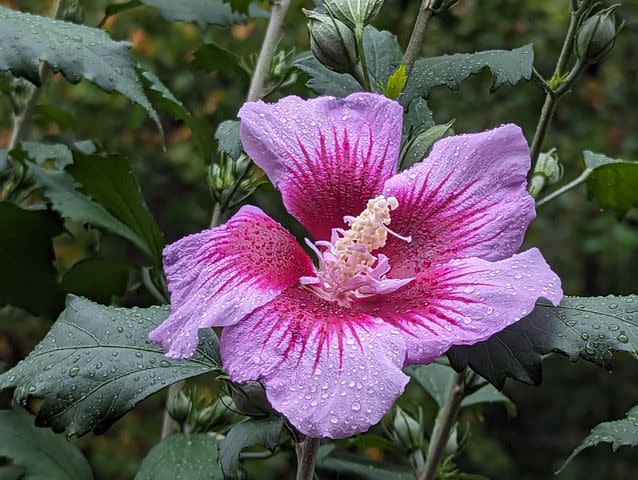
DipaliS / Getty Images
While many rose of Sharon cultivars spread significantly, 'Purple Pillar' grows tall and narrow, maxing out around three feet wide. This makes it ideal for compact spaces. 'Purple Pillar' flowers have pale purple double blooms with deep red throats and a prominent, pale yellow stamen. They thrive in consistently moist soil, especially in their first season, but can tolerate some drought once established.
Name: Rose of Sharon 'Purple Pillar' (Hibiscus syriacus 'Purple Pillar')
USDA Hardiness Zone: 5-9
Mature Height: 10-16 ft.
Sun Exposure: Full, partial
Soil Needs: Moist, well-drained
Flower Color: Purple, red
Water: Keep soil consistently moist
Rose of Sharon 'Orchid Satin'
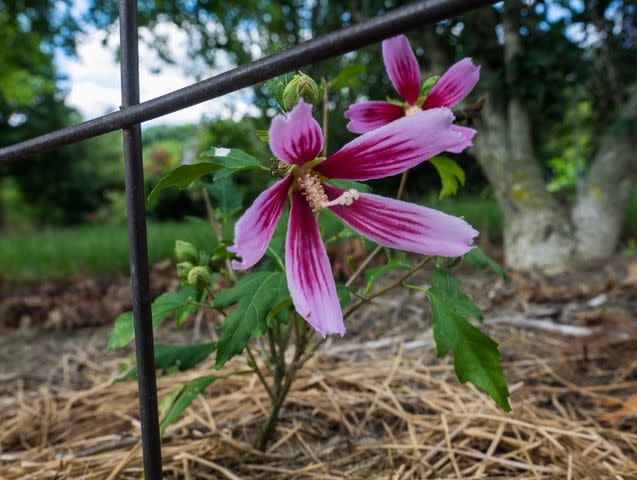
F. D. Richards / Flickr / CC BY-SA 2.0
For hibiscus flowers you can see from a distance, consider rose of Sharon 'Orchid Satin', a tall shrub with large, single pale-pink blooms that have a dramatic red throat and prominent red veining. The large size and full, broad leaves of this seedless cultivar make it excellent for hedges, borders, and privacy screens.
Name: Rose of Sharon 'Orchid Satin' (Hibiscus syriacus 'Orchid Satin')
USDA Hardiness Zone: 5-9
Mature Height: 8-12 ft.
Sun Exposure: Full
Soil Needs: Moist, well-drained
Flower Color: Lavender-pink
Water: Keep soil evenly moist
Rose of Sharon 'Purple Satin'
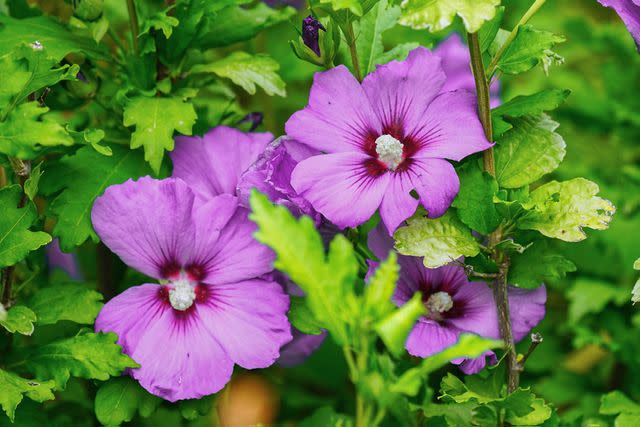
Manuela Schewe-Behnisch / EyeEm / Getty Images
The long-lasting blooms on this tall shrub are rich purple with dark red throats and ivory stamens. This drought-tolerant, heat-tolerant rose of Sharon will flower all summer long. Plant in full sun with plenty of space, as 'Purple Satin' grows nearly as wide as it does tall without pruning.
Name: Rose of Sharon 'Purple Satin' (Hibiscus syriacus 'Purple Satin')
USDA Hardiness Zone: 5-9
Mature Height: 8-12 ft.
Sun Exposure: Full
Soil Needs: Rich, well-drained
Flower Color: Purple, red
Water: Water when soil is drying out
Rose of Sharon 'Sugar Tip Gold'
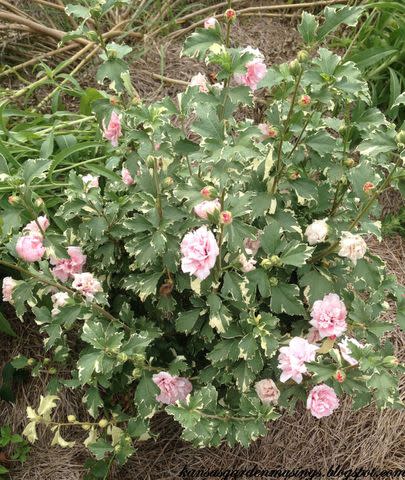
This low-maintenance rose of Sharon offers three-season color, with prominently variegated green-and-gold foliage that appears in spring and lasts into fall. Double purple blooms pop against the gold leaves, and its compact growth habit lends the plant well to containers and borders alike. It's also sterile, so no need to worry about invasive spread.
Name: Rose of Sharon 'Sugar Tip Gold' (Hibiscus syriacus 'Sugar Tip Gold')
USDA Hardiness Zone: 5-9
Mature Height: 4-5 ft.
Sun Exposure: Full
Soil Needs: Well-drained
Flower Color: Purple
Water: Keep soil evenly moist
Tropical Hibiscus
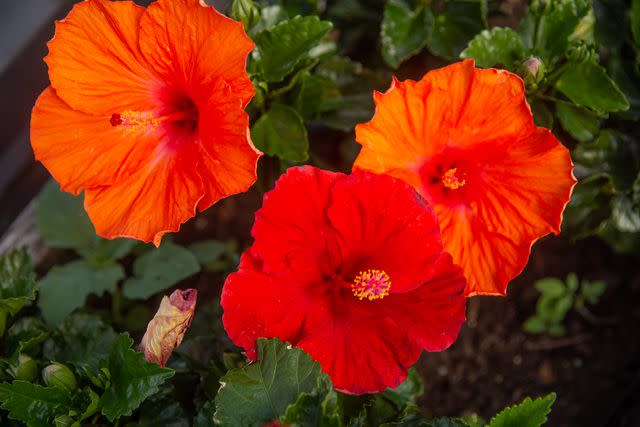
The Spruce / Phoebe Cheong
Aptly named tropical hibiscus thrives in a mild climate, making it ideal for perennial, part-shade gardens in warm regions and annual, full-sun container plantings in cooler regions. This lush hibiscus plant is known for its six-inch-wide, trumpet-shaped blooms in a variety of bright colors. Water frequently to keep the soil evenly moist, which may be as often as twice a day in very hot, dry weather.
Name: Tropical hibiscus (Hibiscus rosa-sinensis)
USDA Hardiness Zone: 9-12
Mature Height: 4–10 feet
Sun Exposure: Full, partial
Soil Needs: Acidic
Flower Color: White, red, pink, orange, yellow, purple
Water: Keep soil consistently moist but not soggy
Hardy Hibiscus
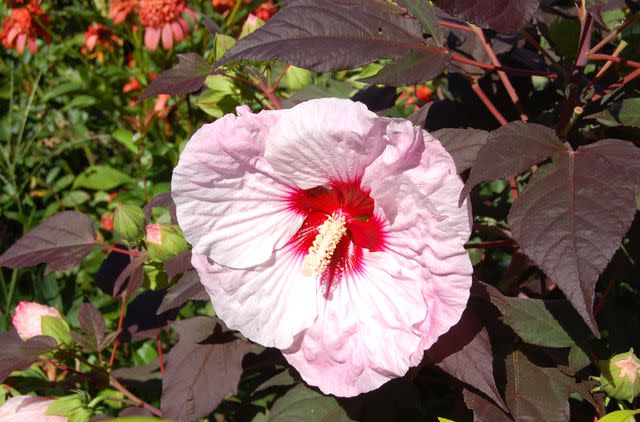
The Spruce / David Beaulieu
If you don't live in a tropical region but love the look of hibiscus, consider hardy hibiscus, which is native throughout the Midwest and East Coast and more tolerant of cool climates. Large blooms with delicate petals come in shades of white, red, pink, and blue, with dozens of eye-catching blooms on a single plant. This wetland species prefers consistently moist, rich soil.
Name: Hardy hibiscus (Hibiscus moscheutos)
USDA Hardiness Zone: 4–9 (USDA)
Mature Height: 3-7 ft.
Sun Exposure: Full
Soil Needs: Moist, rich
Flower Color: White, red, pink, blue
Water: Water deeply to keep soil evenly moist
Roselle
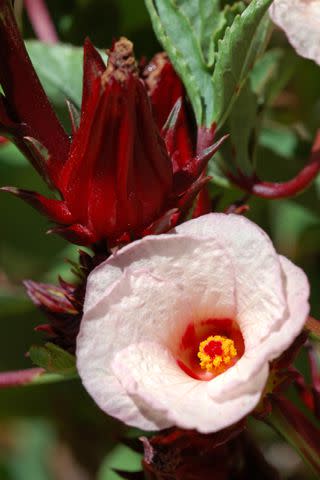
NNehring / Getty Images
Also called Florida cranberry, roselle is the type of hibiscus whose deep red calyces—the parts of the plant that enclose the petals—are used to make tart beverages like sorrel and agua de jamaica. Those buds open into pale pink flowers with deep red centers. Plant this shrubby hibiscus in a spot with well-drained soil and plenty of sun.
Name: Roselle (Hibiscus sabdariffa)
USDA Hardiness Zone: 9-10
Mature Height: 7 ft.
Sun Exposure: Full
Soil Needs: Well-drained
Flower Color: Yellow, dark red
Water: Keep soil evenly moist
Sea Hibiscus
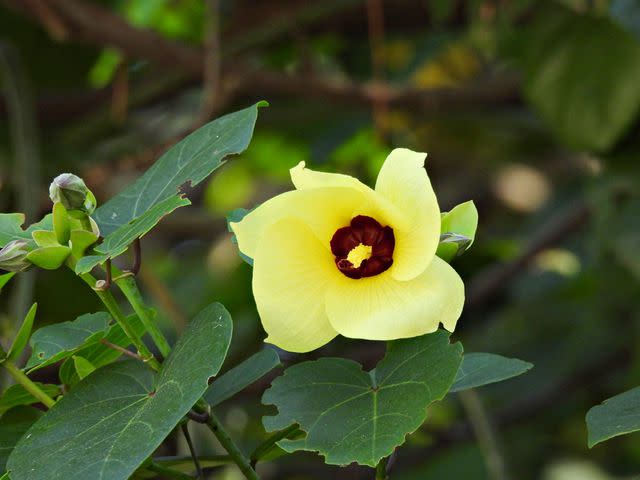
passion4nature / Getty Images
Sea hibiscus, also known as mahoe, is native to tropical regions of Asia but is grown in tropical and subtropical areas worldwide. Profuse, lemon-yellow blooms with deep red centers last one day. Note that sea hibiscus is considered to have invasive potential in coastal regions of southern Florida.
Name: Sea hibiscus (Hibiscus tiliaceus)
USDA Hardiness Zone: 10-12
Mature Height: 12-25 ft.
Sun Exposure: Full
Soil Needs: Well-drained
Flower Color: Yellow, red
Water: Allow soil to dry between waterings
Cranberry Hibiscus
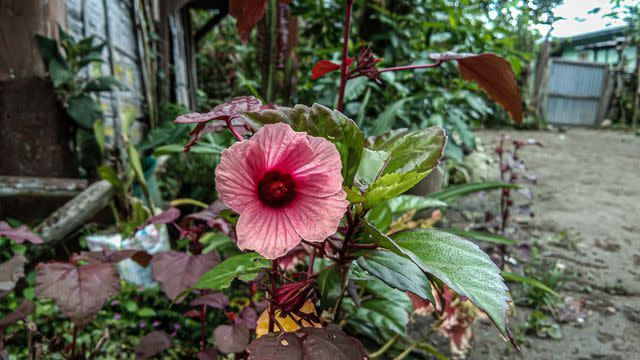
Nurma Susila / Getty Images
Cranberry hibiscus is a rare type of hibiscus that's typically grown for its attractive leaves, not its flowers. This plant has deep red, palmate leaves that are also edible. Full-sun conditions will create the deepest red leaf color. Pink or red flowers may appear in fall.
Name: Cranberry hibiscus (Hibiscus acetosella)
USDA Hardiness Zone: 9a-11b
Mature Height: 3-6 ft.
Sun Exposure: Full
Soil Needs: Well-drained
Flower Color: Red, pink
Water: Keep soil moist
Coral Hibiscus
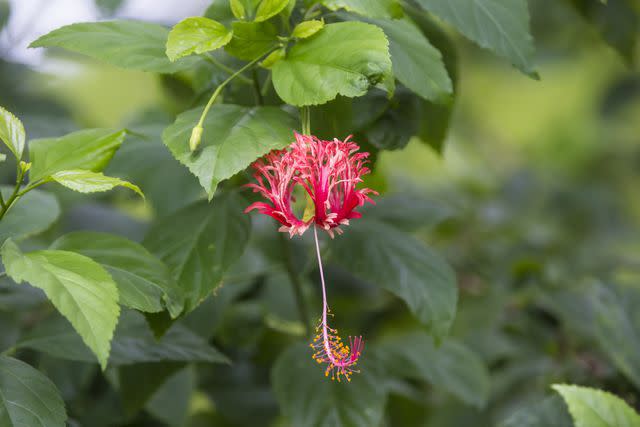
Baiploo / Getty Images
Also called fringed hibiscus or pagoda flower, this unique type of hibiscus grows pendant-like flowers that hang down rather than growing upright, with delicately feathered red petals that curve up from a long, prominent stamen. In cooler climates, this species is typically grown as a container plant, but it can be grown as a perennial border or hedge plant in tropical climates.
Name: Coral hibiscus (Hibiscus schizopetalus)
USDA Hardiness Zone: 10-12
Mature Height: 10-12 ft.
Sun Exposure: Full
Soil Needs: Rich, moist, well-drained
Flower Color: Red
Water: Keep soil consistently moist but not soggy
Swamp Rose-Mallow
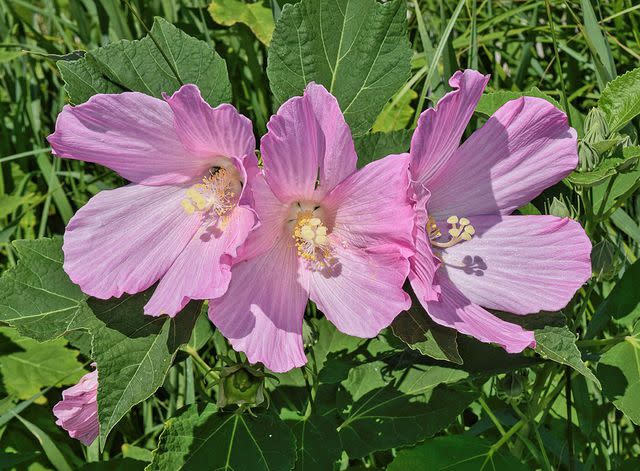
The Cosmonaut / Wikimedia Commons / CC BY-SA 2.5 CA
Swamp rose mallow is known for very large, showy pink blossoms that stand out against velvety green leaves, with as many as 20 flowers at once during peak bloom. This low-maintenance native plant naturally grows around wet, marshy areas in the Midwest and Southeast, making it ideal for rain gardens and low-lying areas.
Name: Swamp rose-mallow (Hibiscus grandiflorus)
USDA Hardiness Zone: 5-9
Mature Height: 3-6 ft.
Sun Exposure: Full, partial
Soil Needs: Acid, neutral
Flower Color: Pink, white, red
Water: Soak plant, frequent standing water
Hamabo Hibiscus
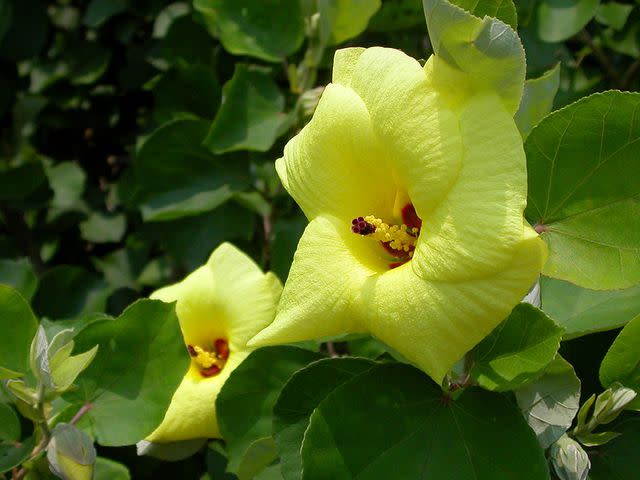
Anonymous Powered / Wikimedia Commons / CC BY-SA 3.0
This hardy hibiscus, native to China, Korea, and Japan, offers bright, cheery blooms from late spring into fall. Flowers start out yellow and darken to orange as they age and attract pollinators like hummingbirds and butterflies. Plant hamabo hibiscus in full sun to partial shade and in an area with good drainage.
Name: Hamabo hibiscus (Hibiscus tiliaceus)
USDA Hardiness Zone: 8-12
Mature Height: 6-15 ft.
Sun Exposure: Full, partial
Soil Needs: Moist, well-drained
Flower Color: Yellow, orange
Water: Keep soil evenly moist but not soggy
Halberd-Leaf Rosemallow
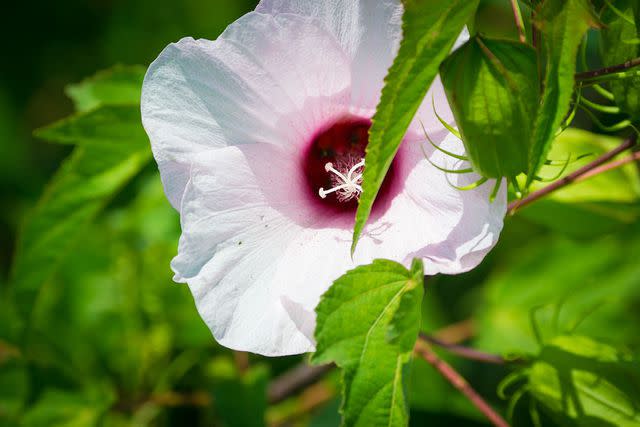
Andrew C /Wikimedia Commons / CC BY 2.0
Looking for a fast-growing plant with hibiscus-type flowers that's native to the Midwest and East Coast? Consider halberd-leaf rosemallow, which grows delicate, cup-shaped blooms in shades of pink or white with red centers throughout the summer. This plant grows best in very moist soil and marshy areas, like rain gardens and wetland habitats.
Name: Halberd-leaf rosemallow (Hibiscus laevis)
USDA Hardiness Zone: 4-9
Mature Height: 6 ft.
Sun Exposure: Partial
Soil Needs: Sandy loam, moist
Flower Color: Creamy white, pink, red
Water: Very high water needs
Hawaiian White Hibiscus
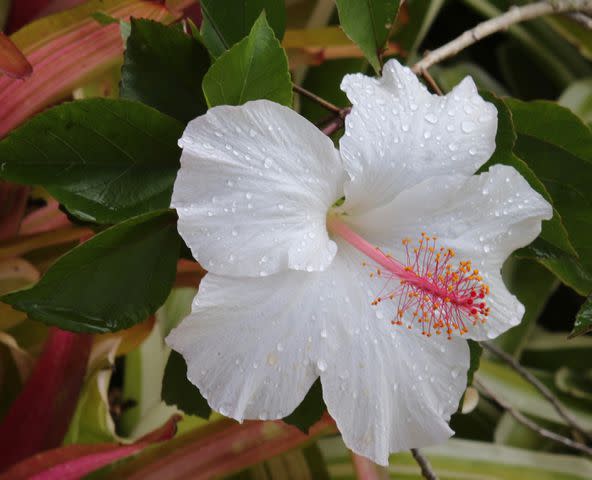
Christie Weekley / Getty Images
Unlike most types of hibiscus, which have no scent, the Hawaiian white hibiscus offers a mild fragrance. This endemic species is only found in the mountains of two Hawaiian islands, Moloka'i and O'ahu, though it's now grown widely in tropical and subtropical climates as a perennial or container plant. Plant in full sun for best flower growth and disease resistance.
Name: Hawaiian white hibiscus (Hibiscus arnottianus)
USDA Hardiness Zone: 9-11
Mature Height: 7-10 ft.
Sun Exposure: Full, partial
Soil Needs: Well-drained
Flower Color: White
Water: Keep soil evenly moist
Woody Rose-Mallow
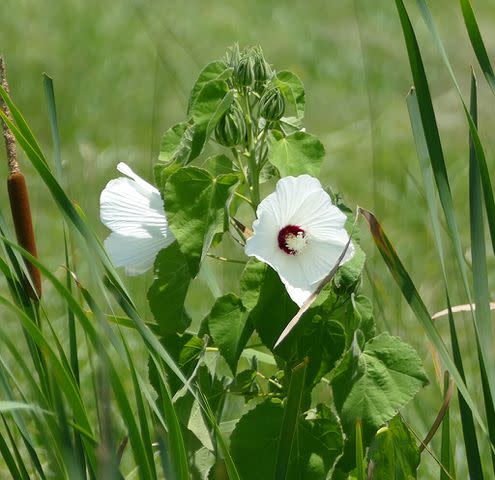
Wendy McCrady / Wikimedia Commons / CC BY 4.0
Also called false cotton, this native type of hibiscus blooms with large, white or pale pink flowers with deep red centers. Bloom period is late spring through early fall. This species tolerates hot, humid weather as long as soil is kept consistently moist.
Name: Woolly rose-mallow (Hibiscus lasiocarpos)
USDA Hardiness Zone: 5-9
Mature Height: 8 ft.
Sun Exposure: Full, partial
Soil Needs: Well-drained
Flower Color: White, pink, red
Water: Keep soil evenly moist
Sleepy Hibiscus
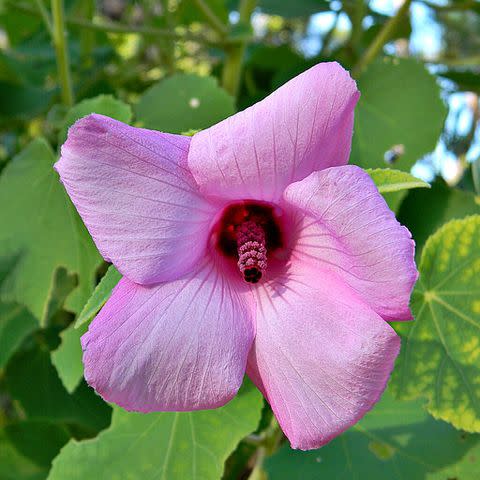
Bob Peterson / Wikimedia Commons / CC BY-SA 2.0
This long-lived perennial is known for its deeply cupped yet showy pink and purple flowers with pink stamens and red centers. Full sun will encourage more blooms and promote disease resistance. In hot, dry weather, plants may require daily or twice-daily watering.
Name: Sleepy hibiscus (Hibiscus furcellatus)
USDA Hardiness Zone: 5-9
Mature Height: 6-8 ft.
Sun Exposure: Full
Soil Needs: Loam, sand
Flower Color: Pink, purple
Water: Keep soil consistently moist
Rock Hibiscus
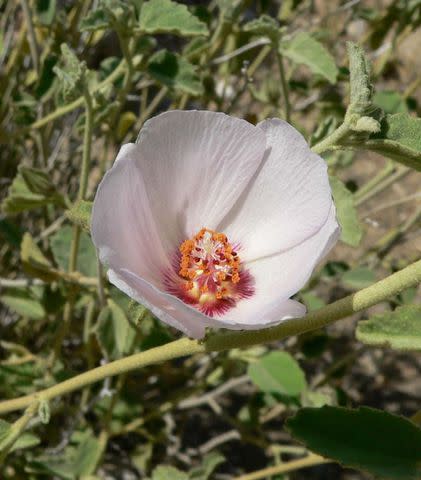
Stan Shebs / Wikimedia Commons / CC BY-SA 3.0
This compact species is much smaller than many types of hibiscus, with less abundant foliage and smaller blooms. However, it's a versatile option for arid climates, being native to the Southwest U.S. and northern Mexico, and is able to tolerate rocky, sandy soils and drought conditions. Pink or purple flowers can bloom throughout the year and will be more profuse with occasional watering.
Name: Rock Hibiscus (Hibiscus denudatus)
USDA Hardiness Zone: 7a, USDA
Mature Height: 1-3 feet
Sun Exposure: Partial
Soil Needs: Well-drained
Flower Color: Pink, purple
Water: Avoid overwatering
Double Hibiscus
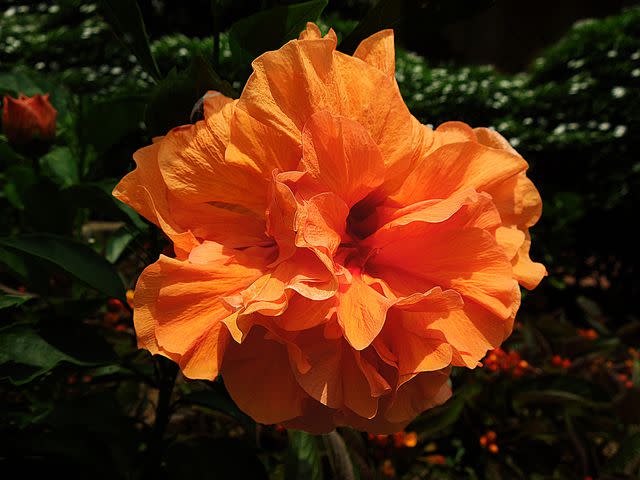
Ravinder Kumar / Getty Images
Some cultivars of tropical hibiscus have been bred for "double" blooms—full flowers with multiple layers of ruffle-like petals. In tropical climates, plants work well as mass plantings, accent plants, and hedges or privacy screens. Double hibiscus also grow well in containers if you're short on space or live in a cooler climate. Prune plants in late fall to maintain their shape and encourage fuller growth next season.
Name: Double hibiscus (Hibiscus rosa-sinensis cv.)
USDA Hardiness Zone: 9-11
Mature Height: 6-10 ft.
Sun Exposure: Full
Soil Needs: Well-drained
Flower Color: Red, pink, yellow, orange, white
Water: Keep soil evenly moist
Hibiscus 'Black Dragon'
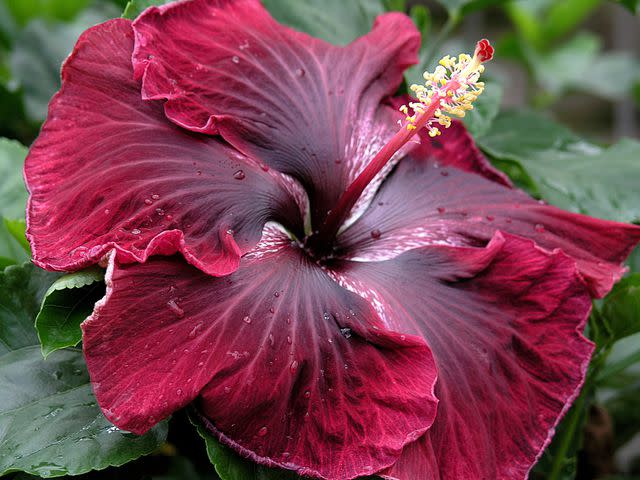
MCT / Getty Images
This award-winning tropical hibiscus hybrid is known for its enormous eight-inch flowers, with crimson petals and rare deep purple centers. Plants are slow-growing and begin to spread once they reach around 18 inches tall. 'Black Dragon' grows well in ground in tropical climates or in large containers as an annual as long as soil is very well-drained.
Name: Hibiscus ‘Black Dragon’ (Hibiscus rosa-sinensis 'Black Dragon')
USDA Hardiness Zone: 9-11
Mature Height: 3-6 ft.
Sun Exposure: Full
Soil Needs: Well-drained
Flower Color: Purple, red
Water: Keep soil evenly moist
Hibiscus 'Fiesta Del Sol'
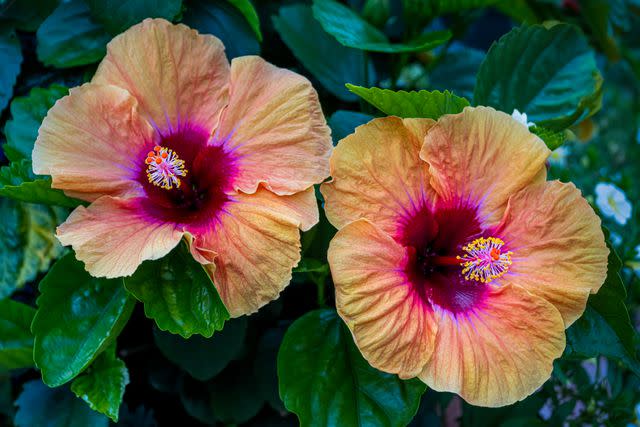
Greg Meland / Getty Images
The stunning, eight-inch multicolored petals on this hibiscus hybrid open orange in the morning before fading to yellow later in the day. Centers are deep burgundy ringed by shocking pink and white. Full sun and consistent water are a must for prolific blooms. Give this hibiscus plenty of space if planting in-ground, or use a large pot for container planting.
Name: Hibiscus ‘Fiesta del Sol’ (Hibiscus rosa-sinensis 'Fiesta del Sol')
USDA Hardiness Zone: 10-11
Mature Height: 2-4 ft.
Sun Exposure: Full
Soil Needs: Well-drained
Flower Color: Burgundy, pink, white
Water: Keep soil consistently moist
Hibiscus 'Midnight Tryst'
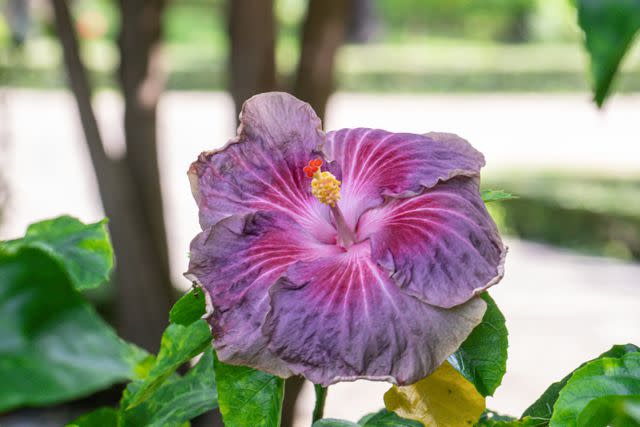
Alohapatty / Getty Images
The wide, multicolored blooms on 'Midnight Tryst' fade by their second day, but the kaleidoscope of colors are worth it. Petals are edged with pink and have a rich purple-gray starburst with white veining leading to a bright red center and yellow stamen. Grow this hybrid in a sunny area with plenty of water and fertilizer to promote blooms.
Name: Hibiscus 'Midnight Tryst' (Hibiscus rosa-sinensis 'Midnight Tryst')
USDA Hardiness Zone: 10-11
Mature Height: 2-4 ft.
Sun Exposure: Full
Soil Needs: Rich, well-drained
Flower Color: Purple, pink, gray, white, red
Water: Keep soil evenly moist
Hibiscus 'The Path'
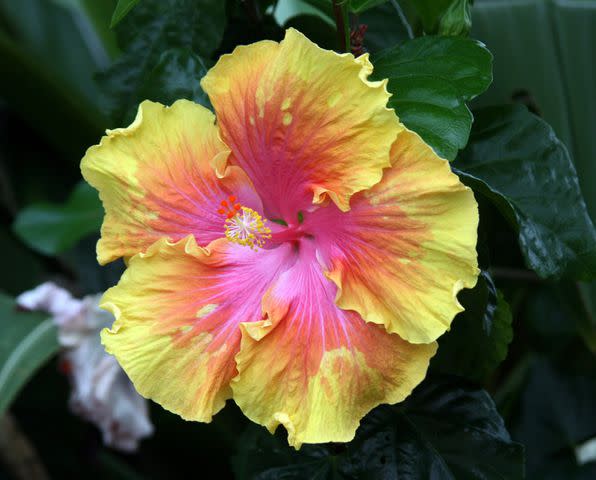
Dcwcreations / Getty Images
Another eye-catching hibiscus hybrid, 'The Path' blooms whose yellow, orange, and deep pink flowers change in color from the edges to the center, lending an ombre effect. Put this light-loving cultivar in a spot with full sun and water regularly during the growing season to keep the soil moist but not soggy.
Name: Hibiscus 'The Path' (Hibiscus rosa-sinensis 'The Path')
USDA Hardiness Zone: 10, USDA
Mature Height: 2-4 ft.
Sun Exposure: Full
Soil Needs: Moist, well-drained
Flower Color: Orange, yellow, pink
Water: Keep the soil evenly moist
Hibiscus 'Voodoo Queen'
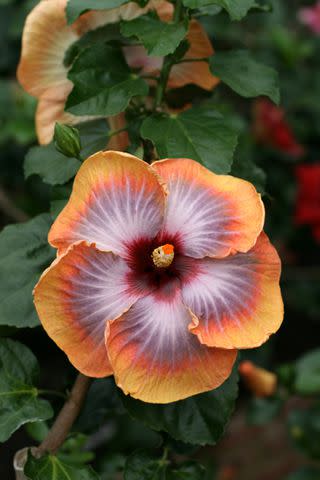
Slowfish / Getty Images
This color-changing hibiscus begins its day with reddish-orange blooms that have a purple center and red throat. By afternoon, the color changes to yellow with lavender-gray centers. Seven-inch blooms pop against glossy, dark green leaves. Give this plant plenty of sun, water, and fertilizer in summer. Keep plants in containers in cool climates.
Name: Hibiscus 'Voodoo Queen' (Hibiscus rosa-sinensis 'Voodoo Queen')
USDA Hardiness Zone: 9-11
Mature Height: 2-4 ft.
Sun Exposure: Full
Soil Needs: Moist, well-drained
Flower Color: Yellow, pink, grey, lavender
Water: Keep soil evenly moist
Hibiscus 'Christmas Angel'
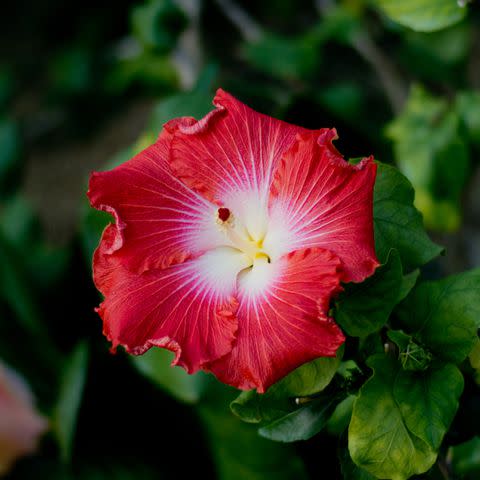
I love photo and apple / Getty Images
While many hibiscus flowers have pale petals and dark centers, festive hybrid 'Christmas Angel' flips this color scheme. Bright red petals frame a vivid white center with prominent white veins. Plant in full sun, or keep indoor specimens in a warm place with bright, direct sunlight, such as a south-facing window. Water and fertilize regularly during the growing season for the best blooms.
Name: Hibiscus 'Christmas Angel' (Hibiscus rosa-sinensis 'Christmas Angel')
USDA Hardiness Zone: 9-11
Mature Height: 2-4 ft.
Sun Exposure: Full
Soil Needs: Well-drained
Flower Color: Red
Water: Keep soil evenly moist
Hibiscus 'Variegated Pink'
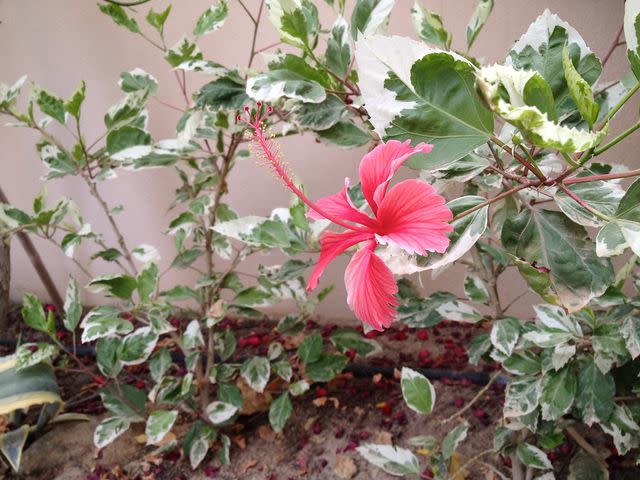
Mahmood Al-Yousif / flickr / CC BY-NC-ND 2.0 DEED
This tropical hybrid offers rare multicolored foliage. The gray-green leaves of this compact type of hibiscus are delicately edged with creamy white. The variegation helps its ruffled pink blooms pop and provides visual interest during the shoulder seasons before and after flowering. Give the plant lots of sun to promote blooms and keep variegation high.
Name: Hibiscus 'Variegated Pink' (Hibiscus rosa sinensis 'Variegated Pink')
USDA Hardiness Zone: 9-11
Mature Height: 2-3 ft.
Sun Exposure: Full
Soil Needs: Moist, well-drained
Flower Color: Pink
Water: Keep moist, but not damp
Hibiscus 'White Hot'
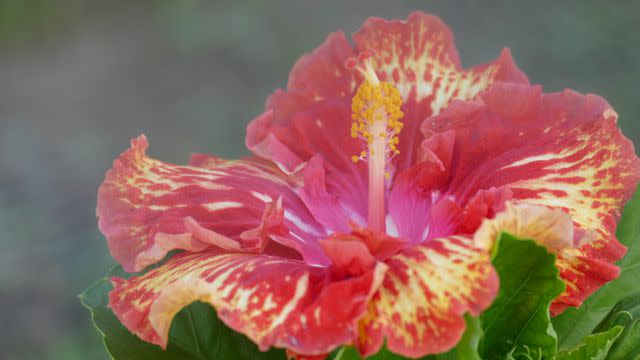
Elio Avila / Getty Images
'White Hot' is a hibiscus hybrid that changes color seasonally. In the cooler days of spring and fall, its large red flowers have yellow speckles and a white center. When the weather gets warmer in summer, the color flips to bright yellow with areas of reddish orange. Plant this bushy, upright shrub in a spot with full sun where you can easily admire its colors.
Name: Hibiscus 'White Hot' (Hibiscus rosa-sinensis 'White Hot')
USDA Hardiness Zone: 9-11
Mature Height: 2-4 ft.
Sun Exposure: Full
Soil Needs: Loam, sandy loam
Flower Color: Red, yellow
Water: Keep consistently moist
Hibiscus 'Queen of Dreams'
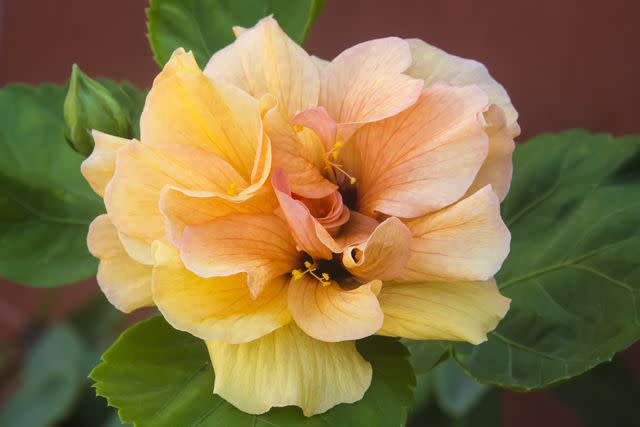
Putu Wiaskara / Getty Images
A rare multicolored double hibiscus, 'Queen of Dreams' blooms with big, frilly flowers that shift in color from peach to pink to lavender. It grows well in containers, as long as they receive full sun, well-drained soil, and regular fertilizer to promote blooming.
Name: Hibiscus 'Queen of Dreams' (Hibiscus rosa-sinensis 'Queen of Dreams')
USDA Hardiness Zone: 9-11
Mature Height: 2-4 ft.
Sun Exposure: Full
Soil Needs: Well-drained
Flower Color: Yellow, orange, rose, and lavender
Water: Keep soil evenly moist
Hibiscus 'Kona'
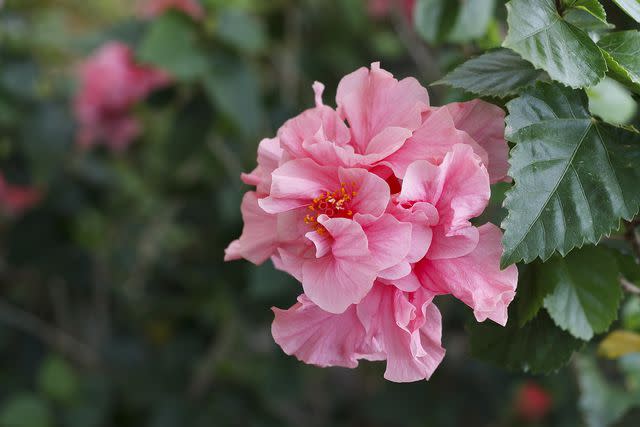
Jeronimo G+E / flickr / CC BY-NC-ND 2.0 DEED
The frilly, double flowers on this hibiscus cultivar shift between shades of pale and darker pink. Abundant blooms appear throughout the growing season rather than during a set period. Plant in-ground in tropical climates, or keep it in a large container in a very sunny spot as an annual in cooler regions.
Name: Hibiscus 'Kona' (Hibiscus rosa-sinensis 'Kona')
USDA Hardiness Zone: 9-11
Mature Height: 2-4 ft.
Sun Exposure: Full
Soil Needs: Moist, light, well-drained
Flower Color: Pink
Water: Keep soil evenly moist
Hibiscus 'Flameball'
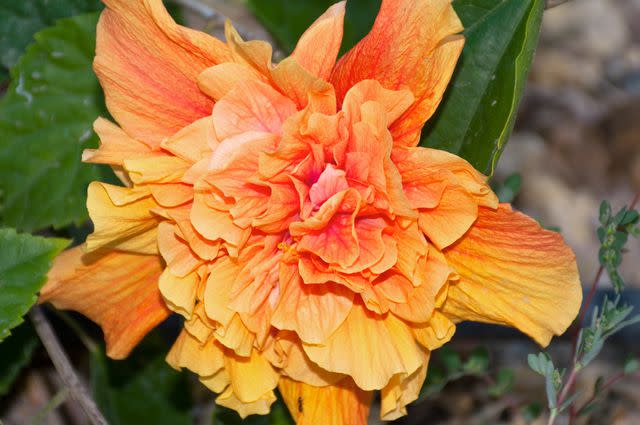
By Eve Livesey / Getty Images
Fluffy double orange blooms streaked or edged with vivid yellow give this hibiscus hybrid its name. Its flowers can grow as large as five inches wide and appear throughout the summer. Grow in full sun and water regularly during summer, cutting back on water slightly in the fall and spring.
Name: Hibiscus 'Flameball' (Hibiscus rosa-sinensis 'Flameball')
USDA Hardiness Zone: 9-11
Mature Height: 2-4 ft.
Sun Exposure: Full
Soil Needs: Well-drained
Flower Color: Yellow, orange
Water: Keep soil evenly moist
Hardy Hibiscus 'Midnight Marvel'
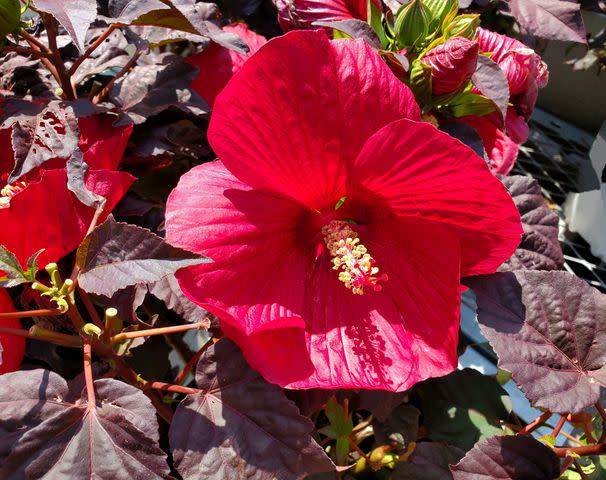
Raksy BH / Getty Images
The deep red flowers of this hardy hibiscus cultivar stand out against dark, purple-green foliage. Its cup-shaped blooms reach nine inches across and appear in midsummer through early fall. This versatile shrub is relatively compact and grows well in wet, swampy areas while tolerating a range of soils.
Name: Hardy hibiscus 'Midnight Marvel' (Hibiscus moscheutos 'Midnight Marvel')
USDA Hardiness Zone: 4-9
Mature Height: 4-5 ft.
Sun Exposure: Full, partial
Soil Needs: Moist, well-drained
Flower Color: Red
Water: Water deeply to keep soil evenly moist
Read the original article on The Spruce.

